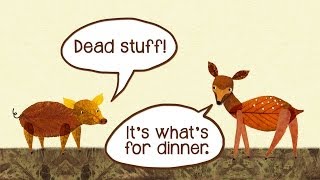(单词翻译:单击)
If someone called you scum, you'd probably be offended, but scientifically, they might not be far off.
如果有人叫你废物,你或许会觉得他冒犯了你,但从科学角度来看,他们可能没完全说错。
Have you ever thought about where your food comes from?
你可否想过你每天吃的食物从何而来?
You might say it comes from plants, animals, or even fungi,
你或许会说这些食物来自植物、动物或者真菌类植物,
but you'd probably rather not think about the rotting organisms and poop that feed those plants, animals, and fungi.
但你可能不愿想到,腐烂的有机物和粪便是植物、动物和真菌类植物的食物。
So really, you and most of the matter in your body are just two or three degrees of separation from things like pond scum.
所以事实上,你以及你的身体的大多数物质,同池塘中的淤泥也不过是两三个食物链级的分别。
All species in an ecosystem, from the creatures in a coral reef to the fish in a lake to the lions on the savannah,
生态系统内的所有物种,从珊瑚礁里的生物到湖里的鱼,再到大草原的狮子,
are directly or indirectly nourished by dead stuff.
都直接或间接地由死去的东西喂养。
Most of the organic matter in our bodies, if we trace it back far enough, comes from CO2 and water through photosynthesis.
我们身体内大多数有机物质,如果我们追根究底,都来自由光合作用产生的二氧化碳和水。
Plants use the energy from sunlight to transform carbon dioxide and water from the environment into glucose and oxygen.
植物用来自光照的能量将环境中的二氧化碳和水转化为葡萄糖和氧气。
That glucose is then transformed into more complex organic molecules to form leaves, stems, roots, fruit, and so on.
葡萄糖又转换为结构更加复杂的有机分子,成为叶、茎、根、果实等形成的基础。
The energy stored in these organic molecules supports the food chains with which we're familiar.
这些储存在有机分子中的能量维持着我们所熟悉的食物链的运转。
You've probably seen illustrations like this or this.
你或许见过与此相似的图表,或者这个。
These green food chains start with living plants at their base.
这些绿色食物链以活体植物作为它们的基础。
But in real-life terrestrial ecosystems, less than 10% of plant matter is eaten while it's still alive.
但在现实的陆地生态系统中,不到10%的植物体在它们依然活着的时候被吃掉。
What about the other 90? Well, just look at the ground on an autumn day.
那么剩下的90%去哪了呢?好吧,那我们就在某个秋天低头看看地上。
Living plants shed dead body parts: fallen leaves, broken branches, and even underground roots.
活着的植物枯萎死去的部分会掉落:败叶、枯枝,甚至是地下的根茎。
Many plants are lucky enough to go their whole lives without being eaten, eventually dying and leaving remains.
很多植物足够幸运能够度过整个生命周期而不被吃掉,最终死去,尸体保留了下来。

All of these uneaten, undigested, and dead plant parts, that 90% of terrestrial plant matter?
那所有那些没有被吃掉,被消化并且已经死去的植物部分,我们前面所提到的90%的陆地植物呢?
That becomes detritus, the base of what we call the brown food chain, which looks more like this.
它们变成了腐质,是我们称之为“棕色食物链”(腐食食物链)的基础,看起来更像这个。
What happens to plants also happens to all other organisms up the food chain:
发生在植物上的一切,也同样发生在食物链上端的其他所有生物身上:
some are eaten alive, but most are eaten only when they're dead and rotting.
有些在活着的时候就被吃了,但大多数在死掉腐烂之后才被吃掉。
And all along this food chain, living things shed organic matter
并且沿着整个食物链,有机物质会从活体上脱落,
and expel digestive waste before dying and leaving their remains to decay.
活体在死之前排出可分解的废弃物并留下它们的遗体,直至腐烂。
All that death sounds grim, right? But it's not.
所有这些死亡听起来很残酷,是吧?但事实并非如此。
All detritus is ultimately consumed by microbes and other scavengers,
所有腐质最终会被微生物及其他食腐动物吃光,
so it actually forms the base of the brown food chain that supports many other organisms, including us.
所以说,腐质事实上是形成“棕色食物链”的基础,支撑了许多其他生物的生存,包括我们。
Scientists are learning that this detritus is an unexpectedly huge energy source, fueling most natural ecosystems.
科学研究发现,出人意料的是,这些腐质是巨大的能量来源,为大多数自然生态系统提供燃料。
But the interactions within an ecosystem are even more complex than that.
但一个生态系统内的相互作用要比这个复杂的多。
What a food chain really represents is a single pathway of energy flow.
一条食物链真正代表的是一个单独的能量流动的途径。
And within any ecosystem, many of these flows are linked together to form a rich network of interactions, or food web,
并且,在任一生态系统中,许多像这样的流动途径彼此交错连结,形成一个强大的相互联系的网络,或称食物网,
with dead matter supporting that network at every step.
死了的东西支撑了这个网络的每一个环节。
The resulting food web is so connected that almost every species is no more than two degrees from detritus, even us humans.
由于食物网各个环节如此紧密相连,以至于食物网中几乎每个物种同腐质的联系都不超过两个消费级,甚至我们人类也包括在内。
You probably don't eat rotting things, poop, or pond scum directly, but your food sources probably do.
你或许不直接吃腐烂的东西,如粪便或者塘泥,但你所吃的食物或许是以这些为生。
Many animals we eat either feed directly on detritus themselves, like pork, poultry, mushrooms, shellfish,
很多我们所吃的动物,要么是直接由腐质喂养的,比如说猪肉、家禽、蘑菇、贝类,
or catfish and other bottom feeders, or they are fed animal by-products.
或者鲶鱼及其他底层动物;要么就是以动物的副产品为生。
So, if you're thinking nature is full of waste, you're right.
所以说,如果你认为大自然充满了废物,你算是说对了。
But one organism's garbage is another's gold,
但你认为是垃圾的东西别人可能认为是金子,
and all that rotting dead stuff ultimately provides the energy that nourishes us and most of life on Earth, as it passes through the food web.
并且所有这些腐烂的死了的东西,随着在食物网中的层层传递,最终提供了喂养我们及地球上大多数生命所需的能量。
Now that's some food for thought.
这的确是让人回味无穷的事实。


